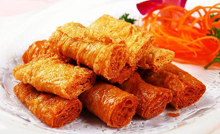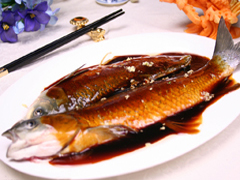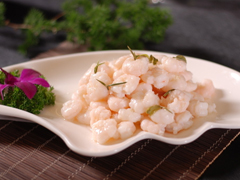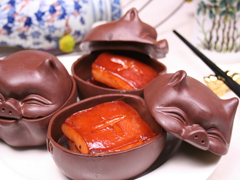
Zhejiang cuisine or Zhe cuisine, is one of the Eight Culinary Traditions of Chinese cuisine. It is derived from the native cooking styles of Zhejiang province in China. Food prepared in the Zhejiang style is not greasy, having instead a fresh and soft flavour with a mellow fragrance.
Background
| | As Zhejiang cuisine consists of hundreds of small delicacies from its main cities, it takes in Hangzhou's fineness and diversification, Ningbo's softness and originality, and Shaoxing's pastoral interests. Hangzhou, once the capital of the Southern Song Dynasty (1127 - 1279), it is customary to endow cuisine with dainty place-names. |
The chief techniques of cooking lie in the methods used such as frying, quick-fry, stir-fry, braising, and steaming thus rendering the dishes both salubrious and savory.
-------------------------------------------------------------------------------------------------------------------------------------------------------------------------
Styles
Zhejiang cuisine consists of at least three styles, each originating from a city in the province
| |
Some sources also include the Wenzhou style as a separate subdivision (due to its proximity to Fujian), characterised as the greatest source of seafood as well as poultry and livestock.
-------------------------------------------------------------------------------------------------------------------------------------------------------------------------
Foods
| West-lake braised fish in vinegar | It is a traditional delicacy in Hangzhou. It is said that there was once a boy who made his living by fishing. When he fell ill, his sister-in-law fished for him and braised the fish she caught with a marinade of vinegar and sugar. He was said to have made an immediate recovery after eating it. The boy's story aroused the attention of the emperor and the recipe has been used ever since. |
| | |
| Shelled shrimps cooked in Longjing tea | As the Longjing tea is taken from the best tea in Hangzhou, which is recognized for greenness, fragrance, pure taste and elegant looks, when the living shrimps are stir-fried in the Long tea, the dish sends an artistic aroma and is quite delicious. |
| | |
| Dongpo pork | The dish is named after revered Song Dynasty poet, artist and calligrapher Su Dongpo, who is supposed to have invented, or at least inspired it. The meat should be so tender that you can quite easily pry it away in small pieces with chopsticks. As it is made from a slab of pork belly, there is a lot of fat, but the lengthy cooking time (3-1/2 hours) results in fat sans much of its greasiness. Eat as little of the fat as you choose. |
| |
Written by Nicolas Yang










